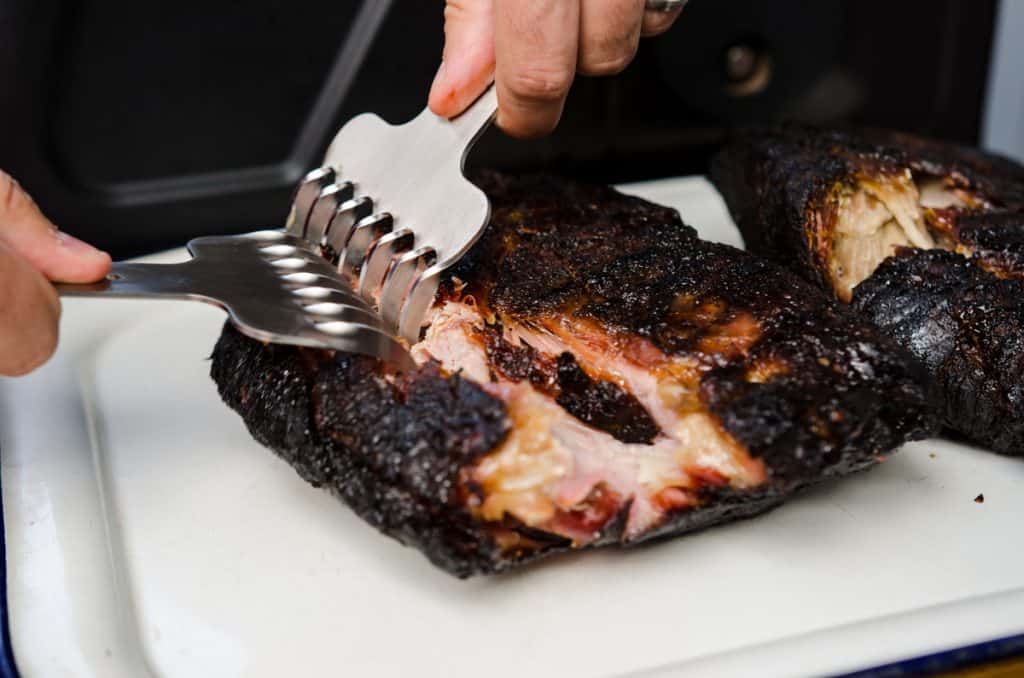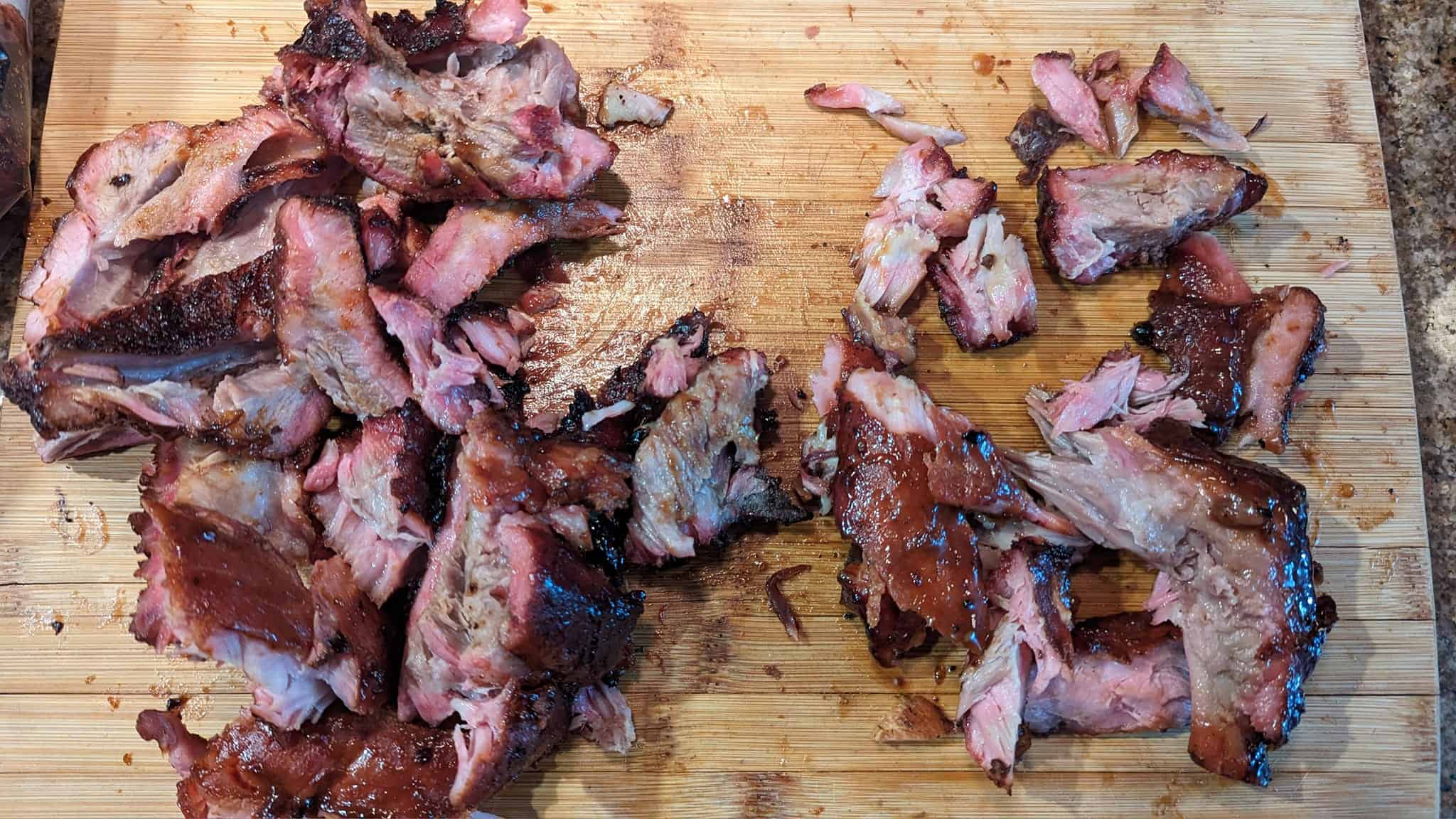There’s nothing like a batch of perfectly cooked pulled pork. When everything goes smoothly, the meat will fall apart with minimal effort, leaving you with meat that’s flavorful, succulent, and juicy.
But why is your pulled pork not shredding as easily as it should? Let’s find out what could be causing this problem, so you can get back on track.
Pulled Pork Not Shredding
When pulled pork isn’t shredding, it could be because the meat didn’t cook long enough. Cooking it too long, or attempting to rush the process by cranking up the heat, are two other common culprits. It’s also important to use a reliable method for shredding the meat.
Possible Reasons for Pulled Pork Not Shredding
Using The Wrong Cut
Pork butt, which is the upper portion of the pork shoulder, is the best cut to use when making pulled pork. Although it’s a fatty cut with a lot of connective tissue, the meat becomes moist and tender when it’s cooked right.
If you use a leaner cut, like pork loin, the meat will probably be overcooked (see below). This makes it tough and difficult to shred. Fortunately, pork butt is usually inexpensive. It’s also easy enough to find, provided you know what you’re looking for.
Don’t trim too much of the fat off the pork butt before adding it to the heat. While you might be put off by the amount of fat you see, most of it will render out during the long cooking process. Just let the smoker do its work. You’ll be impressed with the results.
If you come across a cut that’s labeled as pork shoulder or picnic shoulder, you can use that instead of pork butt. Both are cut from the hog’s foreleg region, but the butt comes from the upper segment, while the shoulder is located lower down.
Overcooked Pork

Overcooked meat is a common issue, especially among beginners. If you cook the meat too fast over high heat, the meat won’t achieve the fall-apart texture that makes pulled pork so desirable. In fact, it may be quite dry and tough.
Pork butt is high in collagen, which breaks down and converts to gelatin at around 160 degrees. At this point, it tenderizes the meat, so the bits that made the meat fatty and tough to begin with are working in its favor.
To avoid overcooking, smoke the pork at a low temperature. 225 degrees Fahrenheit is ideal, but you can set it as high as 275 as long as you keep a close eye on the pulled pork’s internal temp. For best results, the pork should have an internal temperature of 195 to 202 degrees when you take it off the heat.
Undercooked Pork
According to revised guidelines from the USDA, pork is safe to eat when it reaches an internal temp of 145 degrees Fahrenheit. That said, you should never take it off the heat that early if you’re planning to make pulled pork.
For one thing, at that temperature, the collagen hasn’t had a chance to convert into gelatin. That means the meat will still be tough. Moreover, there will be plenty of fat that hasn’t rendered yet. The pork may be safe to eat at this point, but it won’t be appealing. You’ll also end up wasting a great deal of meat.
Pork butt is typically tender enough to shred when the internal temp registers 195 degrees on an instant-read thermometer. For best results, take it off the heat at this point. After it’s had a chance to rest, the meat should come apart under gentle pressure.
You can also leave the pork on the grill until it reaches 202-205 degrees. This will result in a softer texture. Take care not to cook it any longer, though, or the finished product might make better sawdust than dinner.
Cooking Pork Too Fast
Sometimes, the meat has reached the ideal internal temperature, but it’s still not coming apart the way it should. This is more common with smaller cuts, but it can happen no matter what the size.
The truth is that time is just as important as temperature when it comes to making pulled pork. When the temperature is set to 225 degrees, the meat should cook for at least 1-1/2 hours per pound—perhaps even as long as 2 hours per pound. This will allow the connective tissue to dissolve slowly, leaving you with meat that’s tender enough to shred.
Inadequate Tools or Methods

The best way to shred pulled pork—or any other type of slow-cooked meat—is to use a set of shredding claws. These are designed to pull the meat apart quickly, leaving behind minimal waste. The only drawback? You might not be able to sort out any remaining fat or gristle.
If you don’t have shredding claws, you can imitate the process with a pair of sturdy forks. Take one fork in each hand and position them so the prongs are curved outward. Place the forks in the center of the meat, then draw them apart. If you encounter too much resistance, it’s possible that the meat is either overcooked or undercooked (see above).
You can also pull pork apart using your fingers. This takes a great deal of time and effort, but you’ll be able to remove any fatty bits as you go along. Remember to wait until the meat is cool enough to handle.
An electric hand mixer is another possibility. While this method can shred large quantities of pork in a hurry, it can also make the meat too mushy if you overdo it. We would recommend using the electric mixer only if you’re pressed for time, especially when making a huge batch of pulled pork.
Tips and Solutions
When your pulled pork isn’t shredding, is there any way to salvage it? It’s possible—it all depends on what went wrong, and how much time you’re willing to devote to the problem.
If the pork was overcooked, you can chop it into small pieces after it’s had a chance to rest. Try to save as much of the cooking liquid as you can. This will help to rehydrate the meat when you heat up the leftovers.
Pork that isn’t shredding due to undercooked meat is easier to fix. Just put the meat back on the smoker until it’s reached at least 195 degrees. Let it rest for at least 45 minutes, then attempt to shred it again.

Similarly, if you cooked the pork to the correct temperature too quickly, try finishing it off in a crock pot or the oven. Add a small amount of cooking liquid or chicken stock to the pot so it doesn’t dry out, and cook it on low until the meat comes apart easily.
Should you encounter difficulties with your shredding tools, you can switch to another method. Be careful not to over-process the pork, especially if you use an electric mixer. If you make pulled pork often, consider buying a pair of shredding claws to make your task easier.
The Bottom Line
Most of the time, pulled pork refuses to shred because the meat didn’t cook long enough. To achieve satisfactory results every time, set the grill or smoker to 225 degrees Fahrenheit, and let the pork butt cook until it reaches the optimum temperature. There’s no point in rushing the process—it will only waste more time in the long run.
Happy grilling!


Can you link to or share the name of the shredding claws you have pictured? Good write-up, thanks.
Not the exact ones, but these are even better: https://www.amazon.com/1Easylife-Stainless-Shredding-Pulling-Handing/dp/B01IK3D8HA
BBQ Host, thank you for this information. I watched several videos and thought I had the process down, but I pulled a rookie mistake. I went low and slow with the pellet smoker @220 but I took the shoulder out with an internal temp of about 165. The shoulder did not allow for shredding. I’ve used an instant pot in the past and had no problems. While the meat was juicy and the rub was spot on, and that smoke ring (oh that smoke ring), it just didn’t shred. I will know for next time thanks to this article. I’ve bookmarked this site for future bbq endeavors. Keep up the good advice! Thank you!
Hello, I slow cooked a pork loin in spaghetti sauce about 2 hours on low in a pan I have that is like a pressure cooker. Then I cooked in the oven at 225°F overnight still in spaghetti sauce it came out tough and dry I threw it out. I remember my Mom putting her cooked pork chops in the spaghetti sauce that she simmered all day and they were so tender. What did I do wrong?
@Karen L, I think you’re overestimating how long your mom cooked them! Two hours, plus overnight, is pushing TEN hours.
@James D., loin must be rare or it will be tough. I don’t care how slow or long you cook it. There is no collagen to break down.